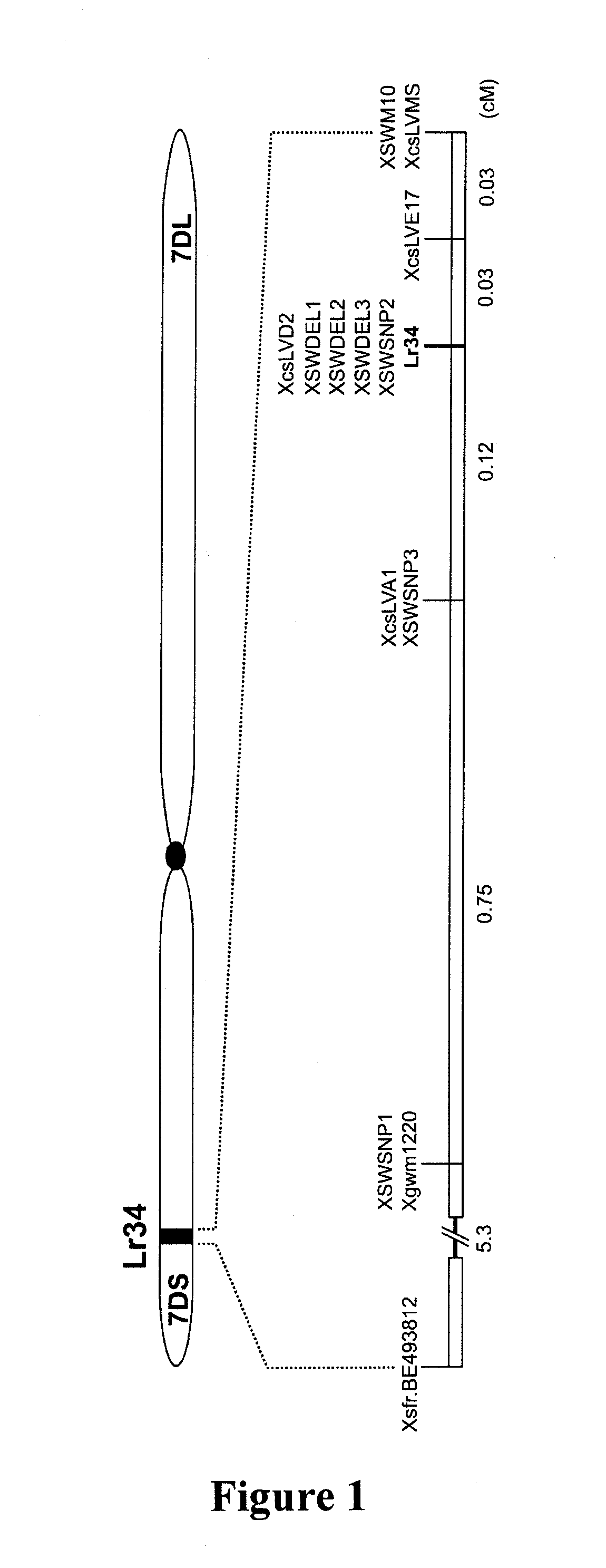Resistance genes
- Summary
- Abstract
- Description
- Claims
- Application Information
AI Technical Summary
Benefits of technology
Problems solved by technology
Method used
Image
Examples
example 1
Materials and Methods
Microscopic Analysis of Seedling Rust Infection
[0207]Plants were grown in a growth chamber maintained at 4-8° C. under a 12 hour light and dark regime. Seedlings were inoculated at the two leaf stage using leaf rust culture 467 and transferred into a humidity chamber (with a temperature range of 16-20° C.) for 24 hours and returned to the 4-8° C. growth chamber. For microscopic visualisation of internal infection structures, the first leaf tissue was autoclaved in 1M KOH, washed in 50 mM KPO4 and stained with a 50 mM KPO4 (pH 7.8) solution containing 20 ug / ml of wheat germ agglutinin (WGA) conjugated to the fluorophore alexa 488 (Invitrogen, USA) staining solution. All WGA-alexa stained tissue was examined under blue light excitation.
RNA Isolation for Semi-Quantitative PCR and Northern Blot
[0208]Total RNA was extracted from leaves using a TRIzol solution (38% Phenol, 0.8M guanidine thiocyanate, 0.4M ammonium thiocyanate, 0.1M sodium acetate pH 5 and 10% glycerol...
example 2
Genetic Mapping of Lr34
Plant Materials
[0211]Three backcross populations were produced and used for genetic mapping of Lr34. The parental parents for the backcrossing, scored phenotypes, population size, and markers mapped on each population are summarized in Table 2.
TABLE 2The three backcross populations that have been used for the high-resolution genetic mapping of Lr34.+Lr34−Lr34nr. ofparentparent+Lr34 backcross lineoriginphenotypic scoringplantsmarkers mappedFornoArinaArina Lr34 (Arina*3 / Forno)Swiss winterLeaf tip necrosis,1728BE493812, SWSNP1, SWSNP2,wheatleaf rust infectionSWSNP3, SWDEL1, SWDEL2,SWDEL3, SWM10, csLVMSPI58548ThatcherRL6058 (Thatcher*6 / PI58548)ChineseLeaf, stripe, and stem1152Gwm1220, BJ280740, csLVD13,landracerust; powdery mildewcsLVD2, csLVMS, BF473324,csLV34ParulaAvocetAvocet Lr34 (Avocet*5 / Parula)CIMMYTLeaf and stripe rust,1152Gwm1220, csLVD13, csLVD2,leaf tip necrosiscsLVE17, csLVMS, csLV34
[0212]The ‘Arina×Forno’ fine-mapping population was developed by cross...
example 3
Mutagenesis and Isolation of Lr34 Mutants
[0218]Seeds of the Lr34 isoline, ‘Lalbahadur Lr34’ were irradiated using a 60Co source at a dosage of 20 krad and the subsequent M1-M5 generations evaluated at CIMMYT, Mexico and in Australia as reported in Spielmeyer et al. (2002). Eight mutants were identified from the gamma-irradiated population. These were analysed using some of the new genetic markers (Example 2). Of the eight mutants, six were interstitial deletions spanning the Lr34 / Yr18 / Pm38 / Ltn1 locus while the two mutants designated m19 and m21 showed no loss of markers in the aforementioned genetic locus. Mutants m19 and m21 were therefore subjected to further analysis utilising the newly identified markers and cosegregating genes.
[0219]Sodium azide mutants were developed using seed from a single head of an RL6058 plant grown in the glasshouse to multiply pure seed stocks for mutagenesis. Seeds were pre-soaked for 12 hrs at 4° C. before treating the grains in an oxygenated solution...
PUM
| Property | Measurement | Unit |
|---|---|---|
| Fraction | aaaaa | aaaaa |
| Fraction | aaaaa | aaaaa |
| Fraction | aaaaa | aaaaa |
Abstract
Description
Claims
Application Information
 Login to View More
Login to View More - R&D
- Intellectual Property
- Life Sciences
- Materials
- Tech Scout
- Unparalleled Data Quality
- Higher Quality Content
- 60% Fewer Hallucinations
Browse by: Latest US Patents, China's latest patents, Technical Efficacy Thesaurus, Application Domain, Technology Topic, Popular Technical Reports.
© 2025 PatSnap. All rights reserved.Legal|Privacy policy|Modern Slavery Act Transparency Statement|Sitemap|About US| Contact US: help@patsnap.com



